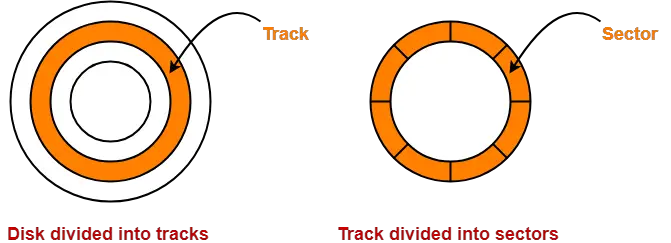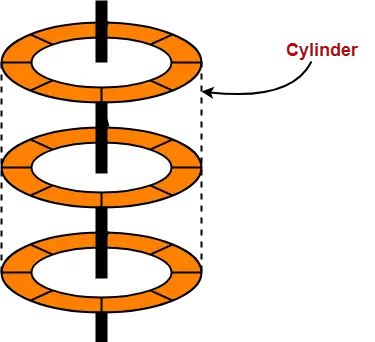Magnetic Disk in Computer Architecture-
In computer architecture,
- Magnetic disk is a storage device that is used to write, rewrite and access data.
- It uses a magnetization process.
Architecture-
- The entire disk is divided into platters.
- Each platter consists of concentric circles called as tracks.
- These tracks are further divided into sectors which are the smallest divisions in the disk.

- A cylinder is formed by combining the tracks at a given radius of a disk pack.

- There exists a mechanical arm called as Read / Write head.
- It is used to read from and write to the disk.
- Head has to reach at a particular track and then wait for the rotation of the platter.
- The rotation causes the required sector of the track to come under the head.
- Each platter has 2 surfaces- top and bottom and both the surfaces are used to store the data.
- Each surface has its own read / write head.

Disk Performance Parameters-
The time taken by the disk to complete an I/O request is called as disk service time or disk access time.
Components that contribute to the service time are-

- Seek time
- Rotational latency
- Data transfer rate
- Controller overhead
- Queuing delay
1. Seek Time-
- The time taken by the read / write head to reach the desired track is called as seek time.
- It is the component which contributes the largest percentage of the disk service time.
- The lower the seek time, the faster the I/O operation.
SpecificationsSeek time specifications include-
1. Full Stroke-
2. Average-
3. Track to Track-
|
2. Rotational Latency-
- The time taken by the desired sector to come under the read / write head is called as rotational latency.
- It depends on the rotation speed of the spindle.
| Average rotational latency = 1 / 2 x Time taken for full rotation |
3. Data Transfer Rate-
- The amount of data that passes under the read / write head in a given amount of time is called as data transfer rate.
- The time taken to transfer the data is called as transfer time.
It depends on the following factors-
- Number of bytes to be transferred
- Rotation speed of the disk
- Density of the track
- Speed of the electronics that connects the disk to the computer
4. Controller Overhead-
- The overhead imposed by the disk controller is called as controller overhead.
- Disk controller is a device that manages the disk.
5. Queuing Delay-
- The time spent waiting for the disk to become free is called as queuing delay.
NOTE-
| All the tracks of a disk have the same storage capacity. |
Storage Density-
- All the tracks of a disk have the same storage capacity.
- This is because each track has different storage density.
- Storage density decreases as we from one track to another track away from the center.
Thus,
- Innermost track has maximum storage density.
- Outermost track has minimum storage density.
Important Formulas-
1. Disk Access Time-
Disk access time is calculated as-
| Disk access time
= Seek time + Rotational delay + Transfer time + Controller overhead + Queuing delay |
2. Average Disk Access Time-
Average disk access time is calculated as-
| Average disk access time
= Average seek time + Average rotational delay + Transfer time + Controller overhead + Queuing delay |
3. Average Seek Time-
Average seek time is calculated as-
| Average seek time
= 1 / 3 x Time taken for one full stroke |
Alternatively,
If time taken by the head to move from one track to adjacent track = t units and there are total k tracks, then-
Average seek time
= { Time taken to move from track 1 to track 1 + Time taken to move from track 1 to last track } / 2
= { 0 + (k-1)t } / 2
= (k-1)t / 2
4. Average Rotational Latency-
Average rotational latency is calculated as-
| Average rotational latency
= 1 / 2 x Time taken for one full rotation |
Average rotational latency may also be referred as-
- Average rotational delay
- Average latency
- Average delay
5. Capacity Of Disk Pack-
Capacity of a disk pack is calculated as-
| Capacity of a disk pack
= Total number of surfaces x Number of tracks per surface x Number of sectors per track x Storage capacity of one sector |
6. Formatting Overhead-
Formatting overhead is calculated as-
| Formatting overhead
= Number of sectors x Overhead per sector |
7. Formatted Disk Space-
Formatted disk space also called as usable disk space is the disk space excluding formatting overhead.
It is calculated as-
| Formatted disk space
= Total disk space or capacity – Formatting overhead |
8. Recording Density Or Storage Density-
Recording density or Storage density is calculated as-
| Storage density of a track
= Capacity of the track / Circumference of the track |
From here, we can infer-
Storage density of a track ∝ 1 / Circumference of the track
9. Track Capacity-
Capacity of a track is calculated as-
| Capacity of a track
= Recording density of the track x Circumference of the track |
10. Data Transfer Rate-
Data transfer rate is calculated as-
| Data transfer rate
= Number of heads x Bytes that can be read in one full rotation x Number of rotations in one second |
OR
| Data transfer rate
= Number of heads x Capacity of one track x Number of rotations in one second |
11. Tracks Per Surface-
Total number of tracks per surface is calculated as-
| Total number of tracks per surface
= (Outer radius – Inner radius) / Inter track gap |
Points to Remember-
- The entire disk space is not usable for storage because some space is wasted in formatting.
- When rotational latency is not given, use average rotational latency for solving numerical problems.
- When seek time is not given, use average seek time for solving numerical problems.
- It is wrong to say that as we move from one track to another away from the center, the capacity increases.
- All the tracks have same storage capacity.
To gain better understanding about magnetic disk-
Next Article- Practice Problems On Magnetic Disk
Get more notes and other study material of Computer Organization and Architecture.
Watch video lectures by visiting our YouTube channel LearnVidFun.

